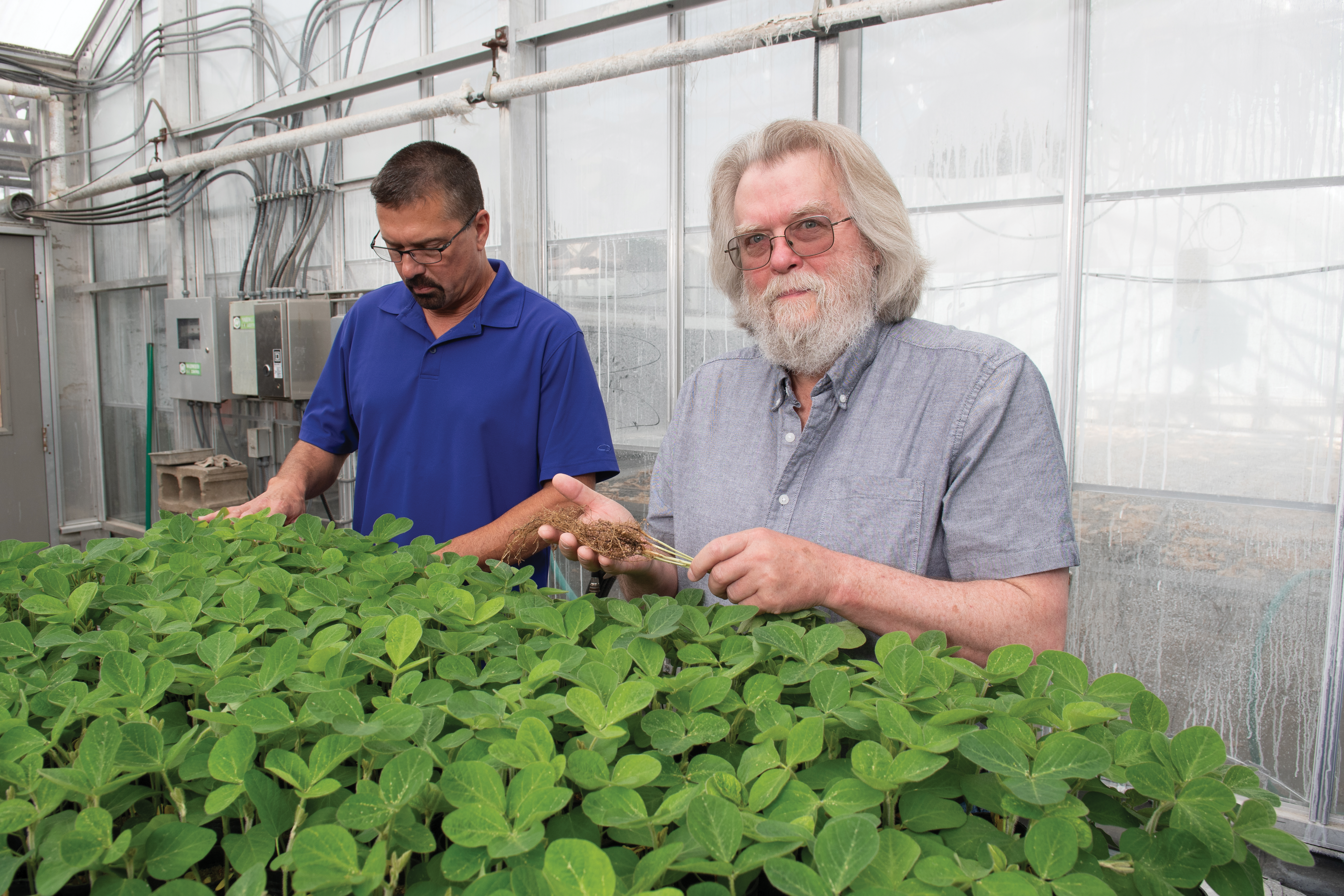Teamwork
 Multi-state projects help K-State researchers solve complex agricultural challenges
Multi-state projects help K-State researchers solve complex agricultural challenges
By Pat Melgares
Photo by Dan Donnert
In his work to track down a microscopic roundworm that wreaks havoc on Kansas soybean fields, K-State nematologist Tim Todd is a team of one.
And yet, he’s not alone.
Like his colleagues at many U.S. land-grant universities, Todd is the only nematologist in the state, but he’s part of a dynamic group that benefits from the Hatch Act of 1887, a government-supported grant program to solve problems that concern more than one state.
Their target: the soybean cyst nematode, which by some estimates is responsible for more than $1 billion and 128 million bushels in soybean production losses across the United States. In North America, the soybean cyst nematode is found in 31 states and Canada, and is thought to cause up to 30% yield loss or more.
“Nematologists in the north central region are a lonely bunch; most of us are the only specialist in our respective states,” Todd said. “So, my career has benefited from having regional colleagues with whom to collaborate. There are national meetings, but those don’t provide the same opportunities for interaction and planning that our smaller, regional meetings do.”
The Hatch Act of 1887 – a portion of which is also known as the Multi-state Research Fund – was passed by Congress to encourage collaboration by researchers at American land-grant universities. It received a boost in the 1998 U.S. Farm Bill, which required multi-state partnerships.
“The federal government allocates about $1.2 million in Hatch multi-state dollars to K-State that is then matched by the state,” said Marty Draper, who retired this summer as associate dean for research and graduate programs with K-State’s College of Agriculture.
“So, at minimum, we’re looking at about $2.3 million at K-State that’s going into multi-state research activities, and we sponsor projects in the Colleges of Agriculture, Veterinary Medicine, Health and Human Sciences, Engineering and Arts and Sciences.”
Draper said any K-State scientist who wants to work on a multi-state project qualifies for an allocation from the Kansas Agricultural Experiment Station. Numerous projects are available for faculty to participate in through a numbered program listing known as the North Central Extension and Research Activity, or NCERA.
“Anytime we have collaborative research going on, we gain valuable insight,” Draper said. “Our methodology improves, our thought process toward research questions improves, and our ability to have more hands working toward completion of our objectives improves.”
K-State veterinary entomologist Cassandra Olds is the lead principal investigator in a multi-state project that focuses on fly management in animal agriculture systems, and its impacts on animal health and food safety.
“Our group has members representing most regions in the U.S.,” Olds said. “I have sent flies to collaborators that have been tested for insecticide resistance, providing us valuable data on Kansas flies…If I need flies or comparisons from other regions in the U.S., I have a resource I can tap into.”
Similar to Todd’s situation, Olds said the field of veterinary entomology “is quite small.”
“If I had to rely on an in-state study program, it is unlikely that it would align well with my research interests,” she said. “I would also not have the opportunity to collaborate and get mentorship from other veterinary entomologists.”
K-State veterinarian and epidemiologist Natalia Cernicchiaro leads a multi-state project that seeks to develop an integrated approach to control bovine respiratory disease (BRD), an infection that causes pneumonia in calves and is thought to be the most common and costly disease affecting beef cattle in the world.
The project involves researchers from Alabama, California, Georgia, Kansas, Mississippi, Nebraska, South Dakota, Texas and Washington.
“Collaboration provides the opportunity to expand the sampling frame of research projects, targeting livestock operations and animals in other regions, which may be advantageous when exploring how regional differences – including management, diet, soil, type of cattle and other factors – may impact animal disease,” Cernicchiaro said.
“As a veterinary epidemiologist working on BRD, I appreciate the perspective that virologists, microbiologists, geneticists and economists – among others – bring to the discussion, and the fact that these collaborations enable development of new fields of inquiry.”
A database provided by K-State’s College of Agriculture indicates that university faculty have participated in 202 Hatch multi-state research projects since 2014, or an average of more than 22 per year.
“With the way that funding runs in our university systems, if we don’t focus on collaborative research, our impact is going to be dramatically reduced,” Draper said. “The collaboration that takes place has to be both internal and external if we want to make sure that we are addressing problems that are relevant and that we are serving underserved audiences.”
Adds Todd: “No one researcher can address all of the important questions for even a single pest. Hatch research projects provide the setting for planning collaborative projects where some of the workload can be spread among the collaborators.”
“This makes for efficient use of individual expertise.”